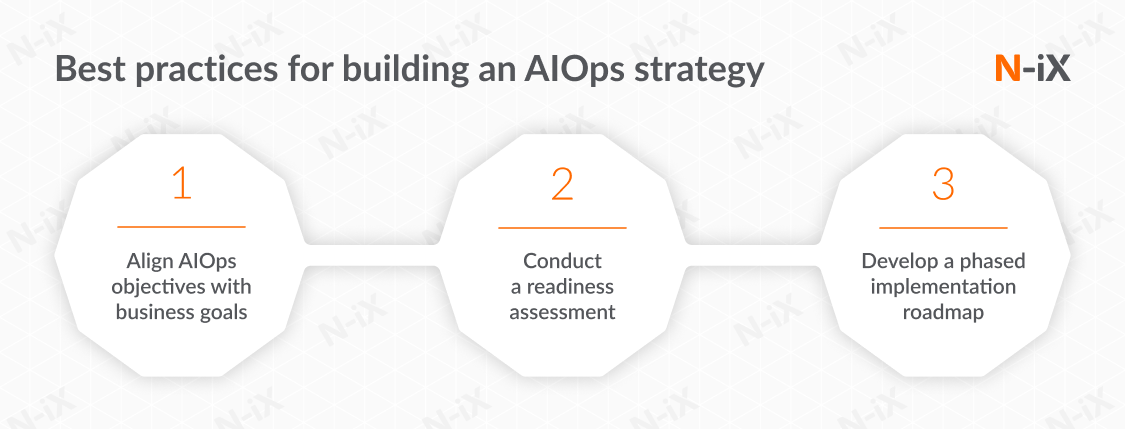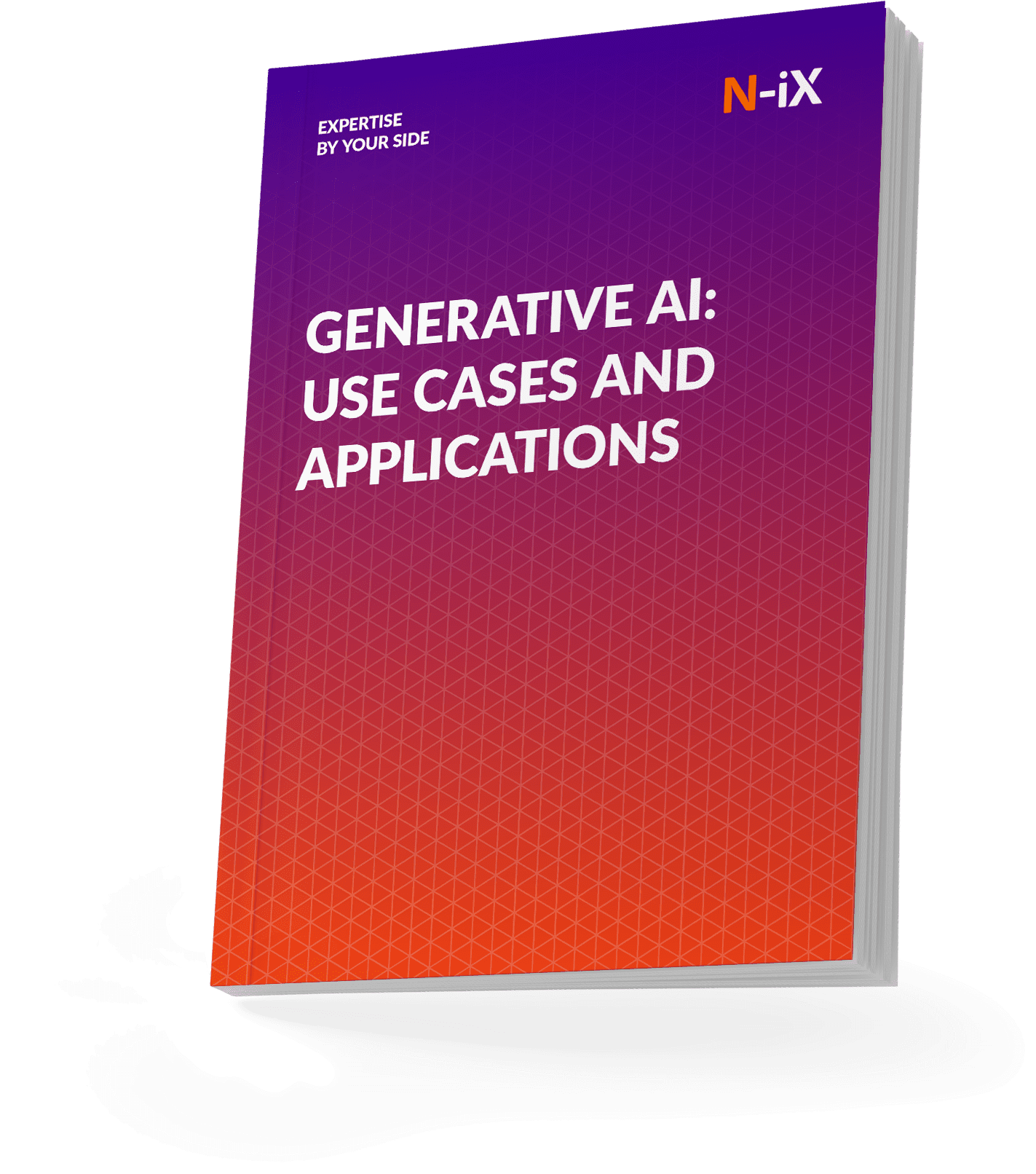Businesses are confronted with IT challenges that range from system outages to security vulnerabilities. Traditional approaches to IT operations are often not ready to handle such issues in a complex environment. Meet AIOps: a tool for integrating Artificial Intelligence and Machine Learning development approaches into IT operations to automate decision-making, enhance system reliability, and accelerate issue resolution.
AIOps is a strategy that leverages AI-powered software intelligence to automate everything, from software development through service delivery to customer interactions. According to IBM, the estimated market size for AIOps is $1.5B, with a compound annual growth rate of around 15% between 2020 and 2025. And since AIOps looks like the future of IT operations, it’s the right time to consider implementing a robust strategy. Let’s learn more about creating a long-term AIOps strategy, review its key components, and assess the industry's best practices.
The growing need for an AIOps strategy
AIOps can become a real game-changer for managing complex IT systems. The term, first coined by Gartner, blends Artificial Intelligence technologies like Machine Learning with Big Data analytics to improve operations. According to Forrester, data and analytics decision-makers report making 48% of business decisions based on quantitative information in 2022. In other words, roughly half of all decision-making could benefit from such solutions as a comprehensive AIOps strategy.
Here’s how AIOps works:
- Data aggregation. AIOps gathers massive amounts of data from various sources like servers, apps, and monitoring tools.
- Smart filtering. Then, it separates important events from minor issues, making spotting patterns and potential problems more manageable.
- Quick solutions. Finally, AIOps can pinpoint the root cause of issues, alert the responsible department, or fix the problem automatically.
Furthermore, AIOps capabilities and monitoring tools can bring dozens of immediate and long-term business outcomes. These include but are not limited to improving CI/CD pipelines, strengthening system resilience, and eliminating tool sprawl. Combining these benefits can offer a comprehensive solution for modernizing IT operations with a unified strategy.
Key questions to consider
An effective strategy involves tackling crucial questions about the role of AI in your IT operations. Below are the key questions you need to consider:
1. What business value will AIOps bring?
The first question defines the business advantages you anticipate from implementing AIOps. Whether improving system uptime, reducing costs, or speeding up an incident resolution, identifying these benefits sets the stage for your strategy design.
2. What data sources will be fed into AIOps models?
Understanding the types of data that will be used for training your AIOps models is essential. This could include log files, performance metrics, or incident reports. Making sense of your data sources allows you to choose the right tools and ensures efficient model training.
3. How will you measure AIOps' effectiveness?
Establish metrics to evaluate whether your AIOps models are delivering the expected results. This could be in the form of KPIs such as reduced mean time to repair (MTTR) or increased system availability.
Addressing these questions is a must to lay a strong foundation for your strategy. This targeted approach simplifies the complexities often associated with broader AI implementations and puts you on the right track for optimizing your operations.
Key components of an AIOps strategy
A robust strategy requires a well-thought-out approach, incorporating specific components for your organization's business needs. Here are six key elements to consider for a successful AIOps implementation:
1. Data lake architecture
Your AIOps system is only as good as the data it accesses. Implementing a data lake architecture allows for efficient storage and management of structured and unstructured data from various sources. This architecture supports advanced analytics, offering a 360-degree view of your IT environment, from logs and metrics to user behavior and service tickets.
2. Algorithm customization
Generic algorithms can offer some insights, but custom-tailored ML models and MLOps services will provide more accurate and relevant information. These models should focus on specific KPIs and metrics most meaningful to your business, whether server uptime, application responsiveness, or user experience metrics.
3. Automated incident resolution
It’s crucial to develop rules and protocols for automated responses to common incidents. They should specify conditions under which automated actions can be taken without human intervention. For instance, if server load crosses a certain threshold, your AIOps system might automatically allocate more resources.
4. Human escalation workflows
Even the best AIOps system will encounter situations that require human expertise. So, it is important to design workflows that identify when an issue should be escalated to a human technician. For example, if a security breach is detected, the system might lock down affected servers and notify your cybersecurity team immediately.
5. Performance benchmarking
Establish baseline performance metrics before implementing AIOps and set clear benchmarks for improvement. This allows you to quantitatively measure the impact of AIOps on system performance, operational efficiency, and other key business metrics.
6. Vendor ecosystem compatibility
It’s vital to remember that AIOps isn't a standalone solution; it must integrate seamlessly with your existing IT tools and vendor ecosystem. Ensure that the AIOps platform you choose is compatible with your current systems for monitoring, service management, and data analytics.

Building a comprehensive AIOps strategy: 7 Steps
Building a sustainable and efficient strategy requires thoughtful planning and execution. Below are seven steps explained:
1. Assess current infrastructure
Begin by thoroughly evaluating your existing IT landscape. This involves examining hardware assets, software applications, and available human resources. Collect data on the tools you use for monitoring, analytics, and automation. Identify gaps, inefficiencies, and bottlenecks that need addressing. This initial assessment will be a foundation for moving forward with all the other steps.
2. Define objectives and KPIs
Clearly articulate what you aim to accomplish with AIOps. This could be reducing operational costs, optimizing system performance, or decreasing incident resolution time. These general goals are converted into specific, measurable KPIs, such as improved mean time to resolution, reduced downtime percentages, or quicker incident response times. Having quantifiable metrics will make it easier to evaluate the strategy's success.
3. Select the right tools
Select AIOps tools that best match your assessed needs and objectives. Consider features like robust data integration capabilities, advanced machine learning algorithms, and compatibility with your existing systems. Keep scalability in mind; the tool should be capable of growing with your organization and adapting to increasing data volumes and complexity.
4. Assemble a cross-functional team
Creating a comprehensive strategy isn't just an IT endeavor. It requires insights from different departments, such as DevOps, Data Science, and Data Analytics. Assemble a cross-functional team of experts to ensure your crafting strategy considers your organization's diverse needs and challenges.
5. Develop an implementation roadmap
With your team in place and your tools selected, the next step is to chart a detailed implementation roadmap. This should outline each rollout phase, including tool integration, data migration, and team training. Prioritize actions that offer immediate benefits or "quick wins" to build momentum and secure early stakeholder buy-in.
6. Pilot and iterate
Before going full-scale with building an AIOps strategy, initiate a pilot program. This could be limited to a specific department or operation within the organization. Collect feedback and performance data to refine your approach. Make adjustments based on what you've learned and repeat the pilot process as necessary until the strategy is ready for full-scale implementation.
7. Monitor, measure, and refine
Once your strategy is operational, continuous monitoring is essential. Utilize the KPIs you established in Step 2 to assess its effectiveness critically. Examine this data regularly and use the insights to refine your strategy, update your roadmap, and identify new areas where AIOps could be beneficial.

With this step-by-step roadmap, you can create a dynamic, long-term strategy that meets your immediate operational needs and scales effectively with your organization's growth.
Common challenges in implementing AIOps and how to overcome them
Implementing AIOps comes with challenges, but the process is surmountable with the right strategies. One of the critical issues is data silos–data scattered across various platforms and tools. A centralized AIOps platform that integrates data from different sources can solve this problem. Additionally, organizations often deal with tool sprawl, where multiple monitoring and analytics tools lead to redundancy and high costs. Auditing existing tools can help consolidate functionalities, simplifying the tech stack.
Budget constraints due to the high initial costs of AIOps solutions can be mitigated by starting with a pilot program to demonstrate ROI. Regarding configuration complexity, seek guidance from vendors or consultants and use best practice templates. In early implementations, false positives are a concern; refining ML models and setting appropriate alert thresholds can minimize this issue. Data privacy is also a concern, so choosing an AIOps solution that complies with regulations like GDPR and features robust encryption and access controls is crucial.
Lastly, be cautious of vendor lock-in, which can limit flexibility–opt for solutions that support open standards. As your organization scales, ensure that your AIOps platform can adapt to handle increased data volumes and complexity.
Read more: AIOps use cases: how to automate and streamline your IT operations
Best practices for building an AIOps strategy
As you navigate the complexities of AIOps, a focused approach can make all the difference. The following best practices are designed to guide you through the strategic layers of implementing AIOps, helping you move beyond mere technical execution to achieve long-lasting business value.
1. Align AIOps objectives with business goals
One of the first steps in formulating a sound strategy is to ensure it aligns closely with your organization's overall business objectives. Whether aiming to improve customer experience, enhance operational efficiency, or mitigate risks, ensure your AIOps goals are designed to contribute directly to these larger ambitions. This alignment is crucial for securing executive buy-in and effectively measuring your AIOps initiatives' ROI.
2. Conduct a readiness assessment
Before diving into AIOps, evaluate the maturity of your existing IT operations and infrastructure. Understand your capabilities, limitations, and the gaps that AIOps can fill. A thorough readiness assessment will guide the strategic selection of tools, the allocation of resources, and the sequencing of implementation phases, ensuring a more targeted and effective rollout.
3. Develop a phased implementation roadmap
AIOps can become too complex and will surely be resource-intensive. Your team needs a phased implementation roadmap for your strategy to manage this. Each phase should have specific milestones, KPIs, and timelines. Starting with a pilot phase allows for fine-tuning before broader implementation and helps set realistic expectations. This roadmap will serve as a strategic guide, ensuring that each step contributes to the overarching goals and that you can make data-driven adjustments as needed.

Final remarks
Implementing AIOps is not a mere technological upgrade; it's a strategic move that can transform your IT operations and drive business value. From aligning with business objectives to fostering cross-team collaboration, a well-thought-out strategy can be your cornerstone for sustainable success in today's complex IT landscape.
As a trusted Data solutions provider, N-iX brings over two decades of experience leveraging cutting-edge technologies to solve complex business challenges. Our comprehensive Data Analytics, AI, and ML solutions are designed to seamlessly integrate into your existing IT operations, empowering you to make data-driven decisions, optimize workflows, and get one step closer to operational excellence. Partner with N-iX to navigate your AIOps journey strategically and realize your organization's full potential.
GUIDE
Get your ultimate guide on Generative AI use cases and applications


Success!

Have a question?
Speak to an expert




